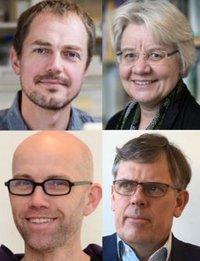4 researchers from iNANO and Department of Chemistry receive DKK 21.4m in total
Alexander Zelikin, Birgit Schiøtt, Frans Mulder and Jørgen Skibsted are among 59 AU researchers who have been successful in the recent call by the Independent Research Fund Denmark. In total the 4 researchers have received DKK 21.4 million.

Totally, the Independent Research Fund Denmark has granted DKK 696 million for 202 research projects all over Denmark.
The research projects span across all academic areas, featuring new, original ideas.
Read the announcement from the Independent Research Fund Denmark (in Danish).
Congratulations to the recipients of the grants (see the list below):
Associate Professor Frans Mulder, email: fmulder@chem.au.dk
“Hierarchical Protein Dynamics”, field: Nature and Universe, amount: DKK 2.875.369
Proteins fold into well-defined 3-dimensional structures and their determination is the holy grail of structural biology.
There is still a good overview of the different movements that are in proteins, and there are clear examples that this limits our ability to, in a rational way, be able to modify proteins, or e.g. develop new drugs. In this project, therefore, the dynamics of protein must be examined in detail, and whether and how it changes with temperature. as well as in live animals.
Associate Professor Alexander Zelikin, email: zelikin@chem.au.dk
“Synthetic artificial internalizing receptors”, Field: Nature and Universe, amount: DKK 6.141.647
Molecular mechanisms in the human cell are extremely detailed and continue to inspire new molecular designs using synthetic organic chemistry. One of the major challenges is the re-creation of cellular receptors (signaling and internalization) using synthetically produced molecules.
The primary goal of this project is to overcome these challenges and design artificial, synthetic receptors that can perform in primary cells (specifically in white blood cells) as well as in live animals.
Associate Professor Jørgen Skibsted, email: jskib@chem.au.dk
“Carbonation Curing of Cementitious Systems (C3S), New Binders and Concrete Recycling”, field: Technology and Production, amount: DKK 6.191.742
Concrete is the most widely used building material in the world, and there are really no alternatives that can replace Portland cement-based concrete. Portland cement is a major source of man-made CO2 emissions (7 - 8%), and reducing it today represents the biggest challenge for the cement industry. The project focuses on two new materials that can greatly reduce the carbon footprint of cement and concrete, and which is based on the chemical bonding of CO2. in the wash mixtures, which consist of chemically complex mixtures.
Professor Birgit Schiøtt, email: birgit@chem.au.dk
“The Virtual Laundromat – Modelling Enzymes in Complex Detergent Mixtures”, field: Technology and Production, amount: DKK 6.191.836
Laundry is responsible for a significant portion of the world's energy consumption and environmental impact through the discharge of microplastics into the wash water. Enzymes added to washing powder have meant a huge advance in reducing the environmental impact, so that it can now be washed at lower temperatures.
In the proposed project, the washing process will be studied in chemical molecular detail as enzyme power is still wasted in the wash mixtures, which consist of chemically complex mixtures.
